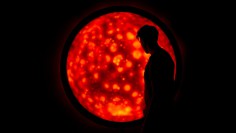RAFAEL LOZANO-HEMMER
Рафаэль Лозано-Хеммер
拉斐尔·洛萨诺 – 亨默
ラファエル·ロサノ=ヘメル
라파엘 로자노
רפאל לוזאנו, המר
Flatsun

source: lozano-hemmer
A circular display that simulates the turbulence at the surface of the Sun using mathematical equations. The piece reacts to the presence of the public by varying the speed and type of animation displayed. If no one is in front of the piece the turbulence slows down and eventually turns off. As the built-in camera detects people more solar flares are generated and the fake Sun shows more perturbation and activity. At 140 cm diameter, Flatsun is exactly a billion times smaller than the real Sun. The piece consists of custom-made panels with 60,000 red and yellow LED lights, a computer with 8 processing cores, a camera with a pinhole lens and a mechanically engineered aluminium, steel and glass structure that pivots for maintenance. A single knob lets the collector set the brightness of the piece and turn it on and off.
.
.
.
.
.
.
.
source: lozano-hemmer
Rafael Lozano-Hemmer was born in Mexico City in 1967. In 1989 he received a B.Sc. in Physical Chemistry from Concordia University in Montréal, Canada.
Electronic artist, develops interactive installations that are at the intersection of architecture and performance art. His main interest is in creating platforms for public participation, by perverting technologies such as robotics, computerized surveillance or telematic networks. Inspired by phantasmagoria, carnival and animatronics, his light and shadow works are “antimonuments for alien agency”.
His large-scale interactive installations have been commissioned for events such as the Millennium Celebrations in Mexico City (1999), the Cultural Capital of Europe in Rotterdam (2001), the UN World Summit of Cities in Lyon (2003), the opening of the YCAM Center in Japan (2003), the Expansion of the European Union in Dublin (2004), the memorial for the Tlatelolco Student Massacre in Mexico City (2008), the 50th Anniversary of the Guggenheim Museum in New York (2009) and the Winter Olympics in Vancouver (2010).
Recently the subject of solo exhibitions at the San Francisco Museum of Modern Art, the Fundación Telefónica in Buenos Aires and the Museum of Contemporary Art in Sydney, he was the first artist to officially represent Mexico at the Venice Biennale with a solo exhibition at Palazzo Soranzo Van Axel in 2007. He has also shown at Art Biennials and Triennials in Havana, Istanbul, Liverpool, Montréal, Moscow, New Orleans, Panama, Seville, Seoul, Shanghai, Singapore and Sydney. Collections holding his work include the MoMA in New York, Tate in London, AGO in Toronto, CIFO in Miami, Jumex in Mexico City, DAROS in Zurich, Borusan Contemporary in Istanbul, MUAC in Mexico City, 21st Century Museum of Art in Kanazawa, MAG in Manchester, MUSAC in Leon, MONA in Hobart, ZKM in Karlsruhe, MAC in Montréal and SAM in Singapore, among others.
He has received two BAFTA British Academy Awards for Interactive Art in London, a Golden Nica at the Prix Ars Electronica in Austria, “Artist of the year” Rave Award from Wired Magazine, a Rockefeller fellowship, the Trophée des Lumières in Lyon and an International Bauhaus Award in Dessau. He has lectured at Goldsmiths college, the Bartlett school, Princeton, Harvard, UC Berkeley, Cooper Union, USC, MIT MediaLab, Guggenheim Museum, LA MOCA, Netherlands Architecture Institute, Cornell, UPenn, SCAD, Danish Architecture Cente, CCA in Montreal, ICA in London and the Art Institute of Chicago.
.
.
.
.
.
.
source: multigrafico
Flatsun es un proyecto de tecnología interactiva el cual simula la superficie del sol, bueno, el aspecto de este. A través de las ecuaciones de Rafael Lozano Hemmer (mexicano) se crea un sistema el cual detecta e interactúa con el público presente en la habitación donde se coloca la obra de arte. A mayor cantidad de personas dentro de la habitación la animación del sol se vuelve más activa y comienza a moverse más rápida; cuando la habitación se encuentra sola la actividad disminuye al punto de que se apaga cuando no hay ninguna persona.
Flatsun es una pantalla circula de 1.42 metros de diámetro dentro de la cual se han colocado 60.000 leds rojos y amarillos que destellan a distintas intensidades para simular los colores de la superficie solar.
Creada originalmente en el 2011, actualmente existen 6 copia de la misma las cuales se exponen en Borusan Foundation (Estambul), ATT (Dallas), y el resto han sido compradas para colecciones privadas en Madrid y Genova.
.
.
.
.
.
.
.
source: vevru
Мексиканский художник Рафаэль Лозано-Хеммер (Rafael Lozano-Hemmer) изобрел гигантскую модель поверхности Солнца. Его интерактивный и технологически продвинутый проект называется Flatsun.
Передняя часть представляет собой круглую панель, которая имитирует поверхность Солнца. Проект основан на различных математических расчетах, которые реагируют на движение в помещении. Когда в комнате многолюдно анимация становится активной. Это отражается на частоте вспышек. Встроенная камера распознает количество посетителей. Однако если в помещении никого нет, вспышки на экране замедляются и, в конце концов, полностью отключаются.
В диаметре Flatsun 1,4 метра. Это в миллиард раз меньше, чем реальное солнце. Состоит из панелей, которые содержат 60000 красных и желтых светодиодов. Съемные стальные части и стекла обеспечивают доступ к задней части в случае необходимого технического обслуживания. Кроме того, небольшая ручка обеспечивает контроль над яркостью и обеспечивает включение-выключение света.
Как и многие другие инсталляции художника, Flatsun призывает зрителей взаимодействовать с его произведениями искусства. Стоя в передней части солнца, посетители могут размахивать руками или двигаться вперед и назад, чтобы зажечь его поярче.
Известный мастер арт-инсталляций Лозано-Хеммер еще с начала 1990-х называл себя электронным художником, создавая крупномасштабные интерактивные постановки в общественных местах. В своих работах он использует новейшие технологии — проекции, звук, свет, интернет, сотовую связь, разнообразные датчики. Основная идея – показать красоту и сложность поведения солнца, зафиксированными астрономическими наблюдениями.

